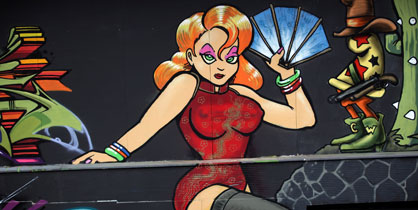
He’s like Madonna in these parts, or Kylie: a single moniker that’s instantly recognisable. Banksy.
Bristol’s most famous son seems to haunt this city, sometimes appearing on its walls, other times merely shaping it with his influence.
You can see the artist’s impact everywhere, in the stencilled designs and spray-painted motifs that litter Bristol’s walls. It’s in the towering 10-storey-high murals and in the smallest brick-wall scrawl. Before Banksy, this stuff was all graffiti. Now, it’s art.
While the true identity of the street artist known as Banksy is still up for debate, the influence he’s had on his commonly accepted home town is not. Banksy wasn’t Bristol’s first street artist and he certainly won’t be its last, but when you see the groups of tourists gathered beneath a seemingly innocuous wall in some arbitrary part of the city, you know whose work they’ve come to see.
Bristol was once a rough port town; it’s now an art gallery. The city’s walls are covered in works by world-famous artists, Banksy, Nick Walker, ROA and SatOne, among others. Those names might not roll off the tongue like Hirst or Twombley, but their skill is undeniable, and the price tags for their works now phenomenal. It’s fortunate it’s all on display, for free, throughout Bristol, the city that spawned the scene.
It can be hard to know where to start, or what you’re looking at, given the sheer coverage of the city’s formerly white spaces. Walk up Stokes Croft Road into Bristol’s more alternative, student-dwelling area and the walls rapidly begin to fill with colour that can seem haphazard at first glance. What is it all And whose is it
Help in this regard comes from the website bristol-street-art.co.uk. On it, every one of Bristol’s major works has been documented, credited and mapped. Click on your favourite artist and pins will drop throughout the city map. Click on the area you’re standing in and you’ve got a guide to that mural you’re staring at.
(There is, however, something important to note: some of the works mentioned in this story may not exist by the time you visit Bristol. They might not even exist today. The fluid nature of the street-art scene means works are constantly being altered or painted over. The fun is in discovering what’s new.)
The most popular search on the website is for Banksy. He’s world-famous, and yet anonymous. He’s shifted street art into the galleries while maintaining a playful political agenda. Like his single-barrelled name, his stencilled artistic style is immediately recognisable.
Watch for the groups standing around the sexual-health clinic on Park Street. Above them is probably Banksy’s most famous work in Bristol, a stencil of a naked man hanging from a window while his mistress and her husband peer outside. The city council had originally planned to destroy the work, but after an internet vote was cast, it was decided that the mural would stay. It has since been defaced, but restored.
Ad Feedback
Another Banksy that hasn’t fared so well is on Stokes Croft Road, an early hand-drawn work of a teddy bear hurling a Molotov cocktail at a group of riot police. The painting has been vandalised numerous times, but groups of fans have always managed to restore it. It’s still one of the easiest Banksys to find – stroll down the hill towards the CBD on Stokes Croft and you can’t miss it.
While Bristol’s street-art scene began illegally, and is often still contributed to in that fashion, there are significant works in the city that have been completed with full approval. Many of those can be found around Nelson Street, on the border of the city centre. This area hosts See No Evil, an annual festival where street artists from around the world are invited to apply paint to the city’s surfaces.
You can’t miss them. Look right, past the “Welcome to Bristol” slogan tagged on a wall, and up towards the sky, and there’s a Nick Walker mural covering about 15 storeys’ worth of apartment block. It’s a bowler-hatted figure pouring red paint down the side of the building, and it dominates the skyline.
Just to the right of that, on the block of flats next door, a 10-storey-high mother nurses a baby – it’s the work of El Mac, an LA-based graffiti artist who was commissioned by the Bristol council.
A stroll down Nelson Street is a crash course in street-art styles. There’s the traditional graffiti work of Feek. There’s a huge, hyper-realistic rat by the Belgian artist ROA. A little further along, the artist SatOne’s abstract vision of four superheroes dominates an entire city block.
But Bristol, of course, isn’t all about the legal art or even the well-known names. The scene began with the underground, and those artists still working in the city’s shadows deserve to be sought out. That’s going to take some exploration, but you might just find the next Banksy. Or maybe even the first one.
FAST FACTS
Getting there National Express runs regular buses from Heathrow to Bristol, taking about 90 min for about $61.5 one way. There are regular trains from London Paddington to Bristol, taking about 9 0min with fares starting at $61.5 one way.
Touring there Bristol’s street-art scene is best discovered solo, and on foot. Just do your research first. Use the website bristol-street-art.co.uk to discover the areas of the city with the highest concentration of works, or where to find your favourites (the Banksys, for example).
More information visitbritain.com.au
– Sydney Morning Herald